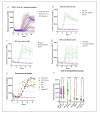Accurate detection of pathologic α-synuclein in CSF, skin, olfactory mucosa, and urine with a uniform seeding amplification assay
- PMID: 40413531
- PMCID: PMC12102825
- DOI: 10.1186/s40478-025-02034-8
Accurate detection of pathologic α-synuclein in CSF, skin, olfactory mucosa, and urine with a uniform seeding amplification assay
Abstract
Currently, early diagnosis of dementia with Lewy bodies (DLB) is based on clinical criteria, which is challenging due to overlapping symptoms with other neurodegenerative diseases. Seeding amplification assays, detecting minute amounts of disease causing α-synuclein (αSynD), are emerging as a promising diagnostic tool for α-synucleinopathies including DLB and Parkinson's disease. This study aimed to test whether the same seeding amplification assay established for αSynD detection in cerebrospinal fluid (CSF) could be applied to other biospecimens, including skin, olfactory mucosa, saliva, and urine, obtained from the same patients. A total of 31 patients with probable DLB and 53 healthy controls were recruited. When evaluating the assays' applicability to different biospecimens, only those collected from participants with a positive CSF αSynD result were considered. Seeding amplification assay results were evaluated based on the αSynD amplification rate over 48 h and the value of the area under the curve. The sensitivity and specificity were 94% and 98% for skin, 47% and 100% for olfactory mucosa, and 22% and 100% for urine, respectively for the CSF positive DLB and healthy controls. αSynD was undetectable in saliva. Cohen's Kappa analysis (κ) showed almost perfect agreement between CSF and skin assays (κ = 0.86) but slight to no agreement for CSF versus olfactory mucosa (κ = 0.12) and urine (κ = 0.094). In summary, the seeding amplification assay established for αSynD detection in CSF demonstrated comparable diagnostic performance in minimally invasive skin biopsies. Olfactory mucosa, saliva, and urine sample preparation pose technical challenges resulting in the established assays' low diagnostic accuracy, for now, limiting their use in diagnostics. Nevertheless, the proof-of-concept for αSynD detection in urine expands the potential for non-invasive diagnostics of α-synucleinopathies in the future.
Keywords: Amplification assay; Cerebrospinal fluid; Lewy body; Neurodegenerative; Olfactory mucosa; RT-QuIC; Real-time quaking-induced conversion; Skin; Urine.
© 2025. The Author(s).
Conflict of interest statement
Declarations. Ethics approval and consent to participate: The study was approved by The Danish Research Ethics Committee (H-22046053 and H-22053428) and The Danish Data Protection Agency (P-2022-668 and P-2022-669). All patients gave written informed consent to participate in the study. Consent for publication: All authors have read and approved this manuscript for publication. All patients gave consent for publication of study results. Competing interests: The authors declare no competing interests.
Figures

References
-
- Adler CH, Beach TG, Zhang N, Shill HA, Driver-Dunckley E, Caviness JN, Mehta SH, Sabbagh MN, Serrano GE, Sue LI, Belden CM, Powell J, Jacobson SA, Zamrini E, Shprecher D, Davis KJ, Dugger BN, Hentz JG (2019) Unified staging system for lewy body disorders: clinicopathologic correlations and comparison to Braak staging. J Neuropathol Exp Neurol 78:891–899. 10.1093/jnen/nlz080 - PMC - PubMed
-
- Arnold MR, Coughlin DG, Brumbach BH, Smirnov DS, Concha-Marambio L, Farris CM, Ma Y, Kim Y, Wilson EN, Kaye JA, Hiniker A, Woltjer RL, Galasko DR, Quinn JF (2022) α-Synuclein seed amplification in CSF and brain from patients with different brain distributions of pathological α-Synuclein in the context of Co-Pathology and Non-LBD diagnoses. Ann Neurol 92:650–662. 10.1002/ana.26453 - PMC - PubMed
-
- Bargar C, Wang W, Gunzler SA, LeFevre A, Wang Z, Lerner AJ, Singh N, Tatsuoka C, Appleby B, Zhu X, Xu R, Haroutunian V, Zou WQ, Ma J, Chen SG (2021) Streamlined alpha-synuclein RT-QuIC assay for various biospecimens in Parkinson’s disease and dementia with lewy bodies. Acta Neuropathol Commun 9:1–13. 10.1186/s40478-021-01175-w - PMC - PubMed
Publication types
MeSH terms
Substances
LinkOut - more resources
Full Text Sources
Medical

